Pickling daikon may take a couple of days but I promise it’s worth the wait. You’ll be amazed at how much umami and saltiness this Japanese vegetable can absorb. Plus, it makes a wonderful side to a steaming bowl of white rice!
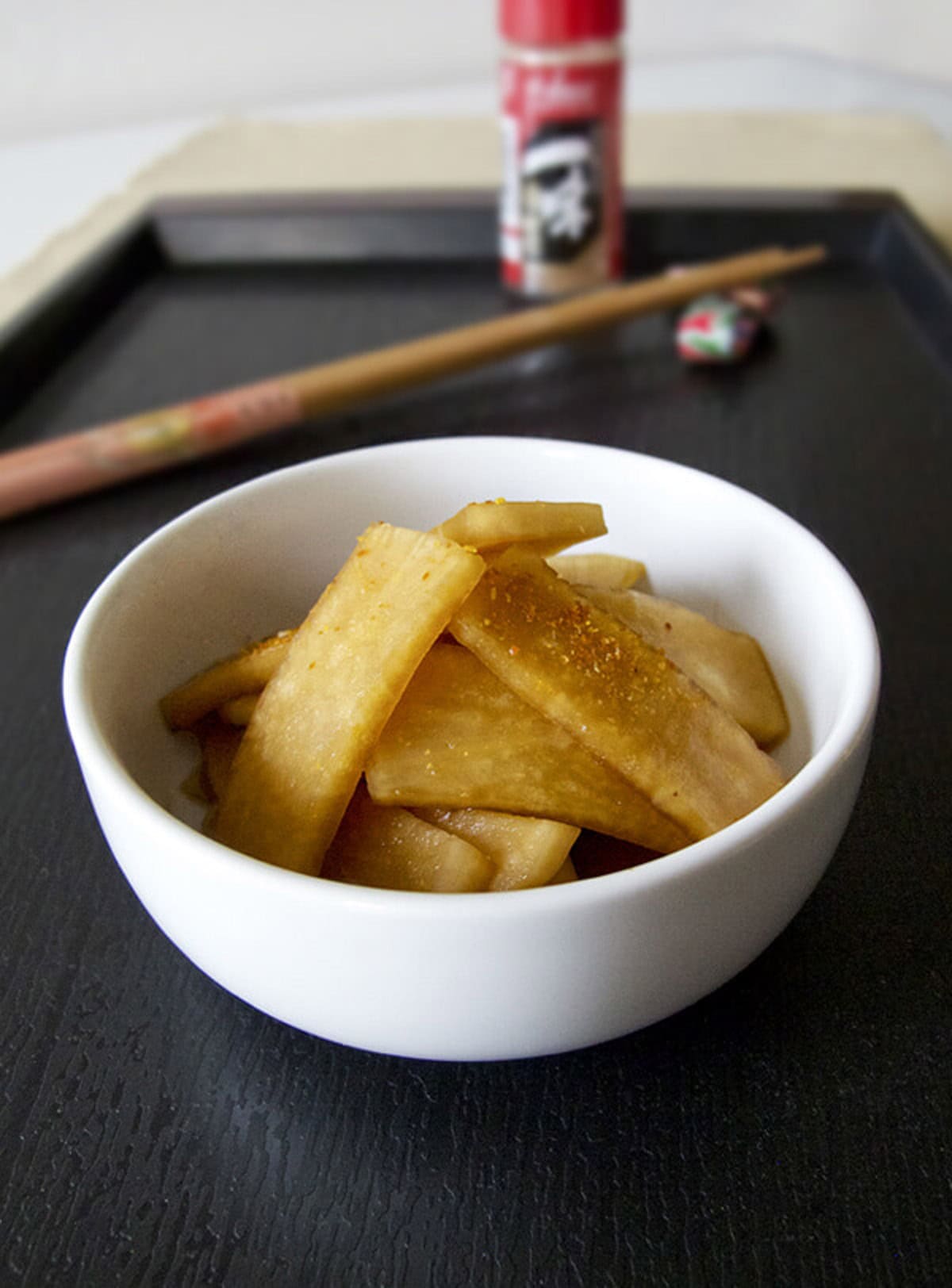
Whenever I make pickles, I know they’ll go quickly because my husband Ben is a pickle addict. Asking him to wait at least two days before he can dump a pile of pickled daikon onto his bowl of rice is like asking ice cream lovers to wait until summer to enjoy this sweet treat.
Not fair.
Because it’s so hard to keep a jar of pickle intact in my kitchen, I can tell you these pickled daikon radish can technically be enjoyed after just 3 hours of sitting in the refrigerator. However, the flavor won’t be nearly as good so if you can wait a little longer, do so.
When it’s ready, pour yourself a glass of cold sake and take a bite. Holy molly, garlicky but oh so yummy!! Spicy garlic meets savory in these umami filled daikon radish bites, with a touch of sweetness that hits in the very end. The taste lingers in your mouth and though it is quite strong, it is also very satisfying.
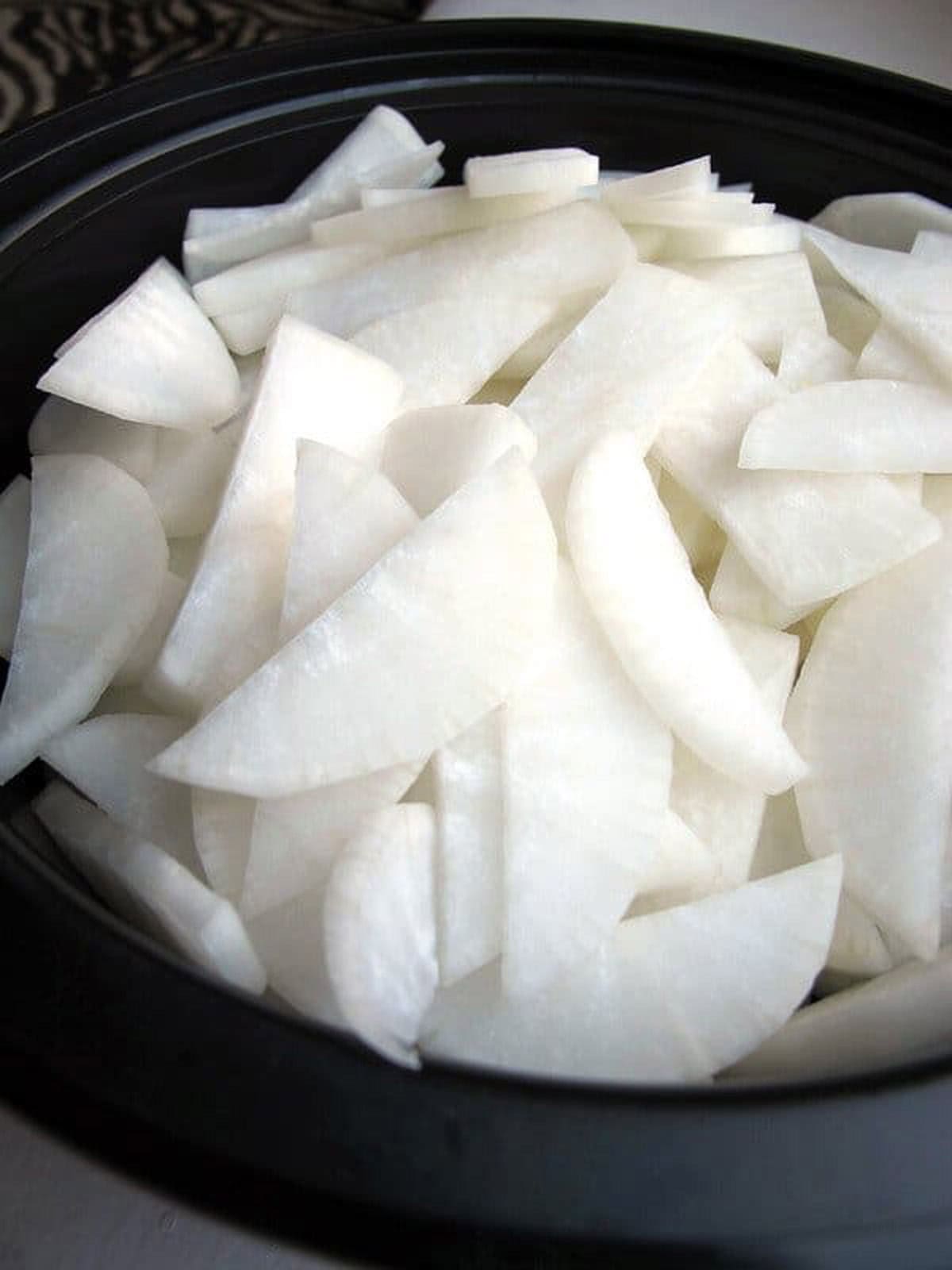
What Is Daikon?
Daikon is a Japanese radish that is long, white, and has a crunchy texture. It’s unique from many other root vegetables because of its specific flavour profile being super sweet and peppery. You can find them at your local Asian grocery store. Japanese daikon radish can often be found in salads, soups, and other Japanese dishes.
Ingredients For Pickled Daikon
- Daikon: Make sure you peel the outside part of the daikon well otherwise you may end up with very crunchy and bitter exterior. One easy way to find out how far to peel the daikon skin is to cut one end and look at the inside. You should see an outer ring that’s a bit whiter than the inside, which can sometimes be quite thick – that’s the part you want to peel.
- Soy sauce: Regular Japanese soy sauce such as Kikkoman or Yamasa. Japanese soy sauces are more complex in flavor which is why I’m being specific.
- Light soy sauce: I’m using a little light soy sauce because of its saltier taste. But it’s not absolutely necessary to use it. If you only have regular soy sauce available, please go ahead and use that.
- Rice wine vinegar: Plain rice vinegar or apple cider vinegar can also be used.
- Mirin: A little mirin to add some sweetness.
- Garlic: One crushed raw garlic clove adds a little sweetness and spiciness.
- Water: Some cold water to dilute the flavors and bring a nice balance.
Additional Ingredients To Explore With
There are more than several ways to make pickling liquid depending on what you want your desired outcome to be. For these specific pickles you can:
- Add red chili to add heat.
- Add gochugaru (Korean chili pepper flakes) to add smokiness and heat. If you love a good Korean side dish, banchan style, I suggest adding 1 tablespoon of gochugaru.
- Swap the rice vinegar for white vinegar for a more tart flavor.
- Add white sugar to sweeten the pickles.
- Kosher salt or table salt for a saltier taste.
You can also use other vegetables such as carrots, celery, zucchini, bell peppers, or regular radish, for this recipe. The pickle brine works well for just about everything!
How To Pickle Daikon
- Start by prepping your ingredients.
- Gather all of your kitchen tools and ingredients.
- Mix all the ingredients for the pickling liquid in a bowl and stir well.
- Put the daikon slices in a large storage bag and add the pickling liquid.
- Gently move the liquid around so it coats all daikon pieces and let the air out of the storage bag before sealing it shut.
- Refrigerate for at least 2 days and up to 1 week for a stronger taste.
These pickled daikon radishes pair well with a variety of side dishes and are also really delicious with Japanese fried rice (yakimeshi), as a condiment for banh mi sandwiches, or as a topping for bibimbap.
More Pickle Recipes You Might Like
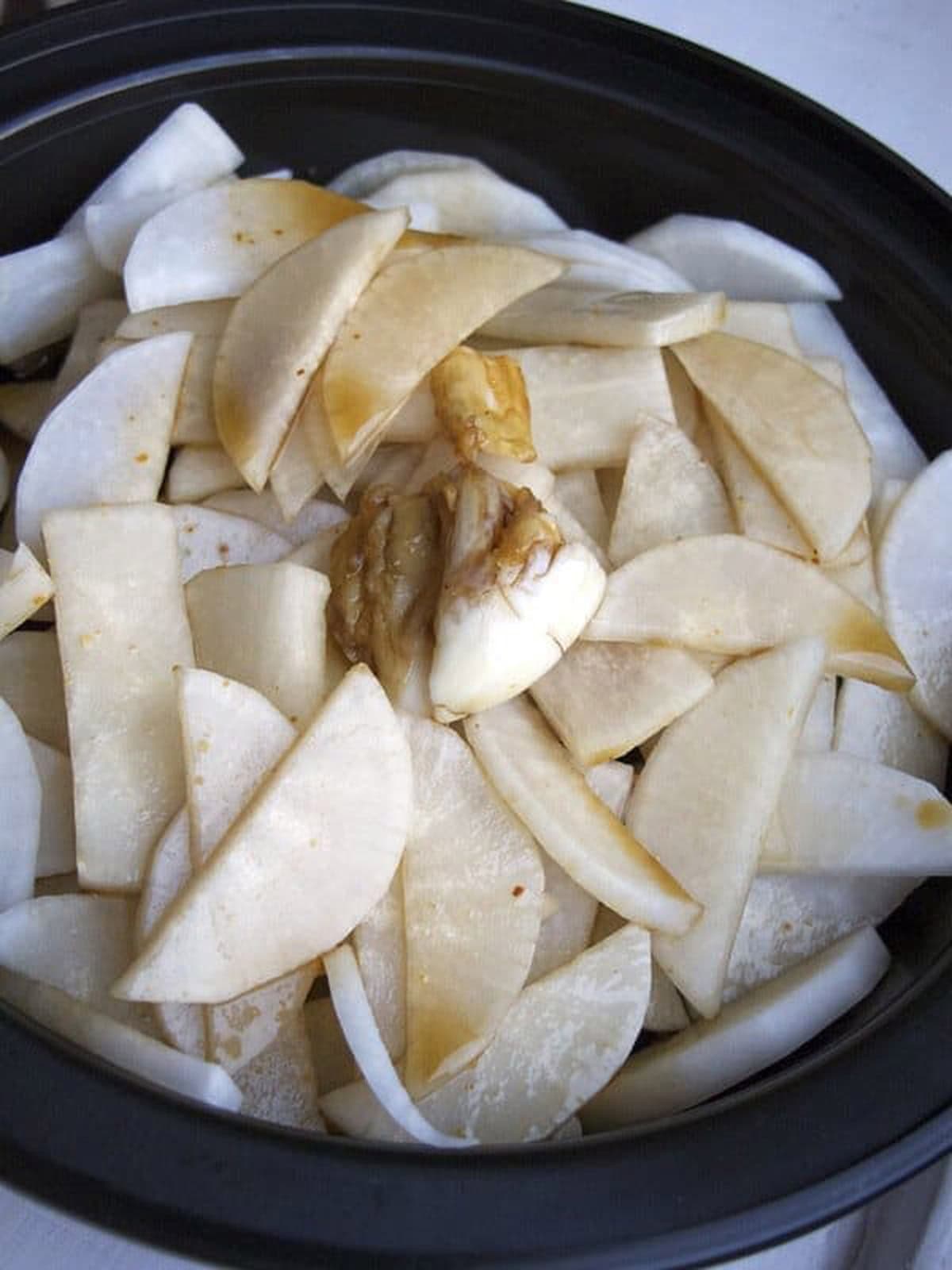
What do you think about this pickled daikon recipe? Have you pickled food before? What are your favorite things to pickle? Let me know in the comments below!
Print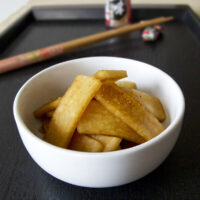
Pickled daikon (Japanese style)
- Prep Time: 10 minutes
- Cook Time: N/A
- Total Time: 10 minutes
- Yield: 4 servings 1x
- Category: Pickle
- Method: Pickling
- Cuisine: Japanese
- Diet: Vegan
Description
This is an easy umami packed Japanese Style Pickled Daikon recipe that pairs beautifully with a bowl of rice or that can be enjoyed as a snack or a flavor booster for sandwiches.
Ingredients
- 2 cups daikon, peeled and chopped bite size
Pickling liquid:
- 3 tablespoons Japanese soy sauce
- 1 tablespoon Japanese light soy sauce
- 1 cup water
- 2 tablespoons rice vinegar
- 1 tablespoon mirin
- 1 clove garlic, crushed
Instructions
- In a bowl, mix all the ingredients for the pickling liquid and stir.
- Put the daikon in a large tupperware container and pour the pickling liquid over.
- Mix well, cover and refrigerate for at least 2 days and for up to 1 week for a more intense flavor. When you are happy with the taste, get rid of the pickling liquid.
Notes
Keep the pickles in a glass jar or airtight storage container for up to 3 weeks.
Nutrition
- Serving Size: 1 serving
- Calories: 17
- Sugar: 0.6g
- Sodium: 333.1mg
- Fat: 0.1g
- Saturated Fat: 0g
- Unsaturated Fat: 0g
- Trans Fat: 0g
- Carbohydrates: 2.9g
- Fiber: 0.7g
- Protein: 1.5g
- Cholesterol: 0mg
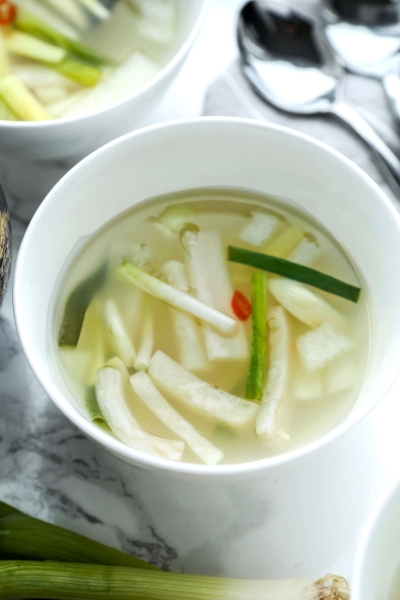
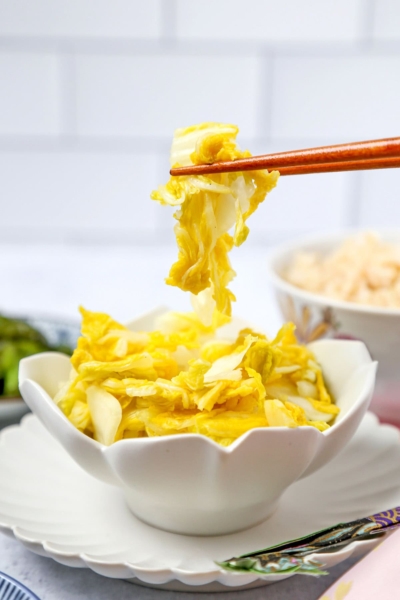
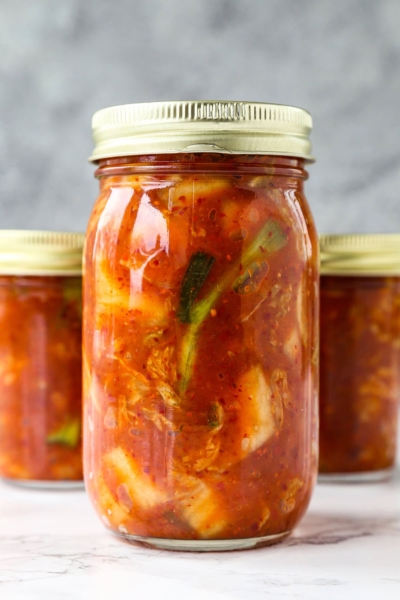
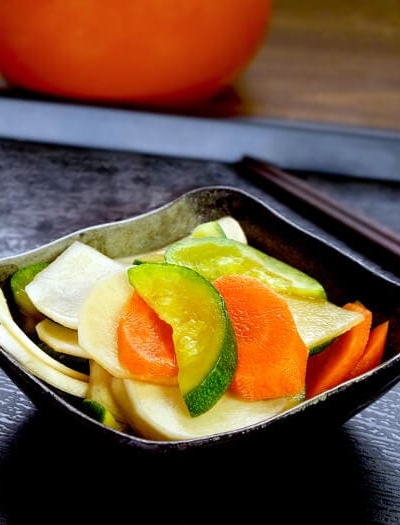















Questions and Reviews
Your recipe has soy sauce & light soy sauce. What is the difference? What brand do you use? Local or japanese
Hi Odelia, light soy sauce is saltier than regular soy but you can swap one for the other if you don’t have both. I do it all the time 🙂
You mention light soy sauce in the recipe. I am assuming you mean usukuchi (lighter in color), but you may mean usujio (lower in salt content). Given that the two have distinct flavors I thought I would ask for clarification. Also, when you say one garlic, I assume you mean a clove and not a head, yes?